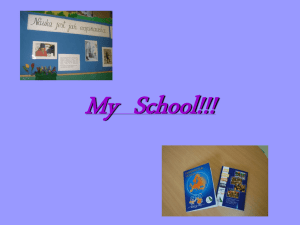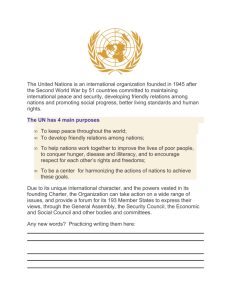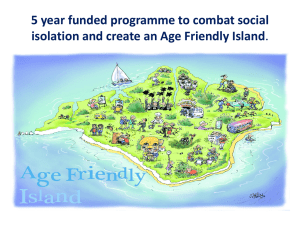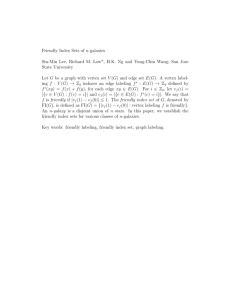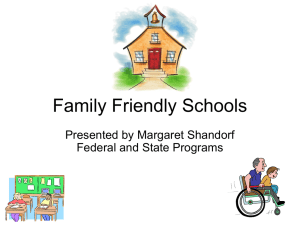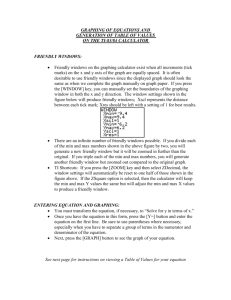Short Story Unit
advertisement
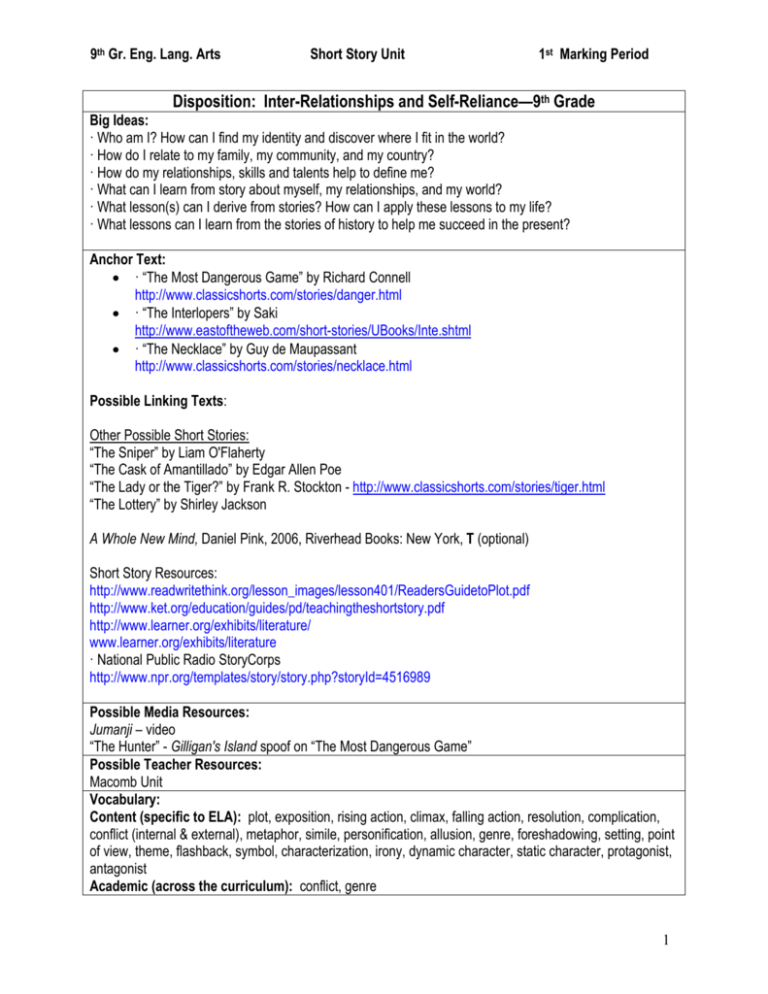
9th Gr. Eng. Lang. Arts Short Story Unit 1st Marking Period Disposition: Inter-Relationships and Self-Reliance—9th Grade Big Ideas: · Who am I? How can I find my identity and discover where I fit in the world? · How do I relate to my family, my community, and my country? · How do my relationships, skills and talents help to define me? · What can I learn from story about myself, my relationships, and my world? · What lesson(s) can I derive from stories? How can I apply these lessons to my life? · What lessons can I learn from the stories of history to help me succeed in the present? Anchor Text: • · “The Most Dangerous Game” by Richard Connell http://www.classicshorts.com/stories/danger.html • · “The Interlopers” by Saki http://www.eastoftheweb.com/short-stories/UBooks/Inte.shtml • · “The Necklace” by Guy de Maupassant http://www.classicshorts.com/stories/necklace.html Possible Linking Texts: Other Possible Short Stories: “The Sniper” by Liam O'Flaherty “The Cask of Amantillado” by Edgar Allen Poe “The Lady or the Tiger?” by Frank R. Stockton - http://www.classicshorts.com/stories/tiger.html “The Lottery” by Shirley Jackson A Whole New Mind, Daniel Pink, 2006, Riverhead Books: New York, T (optional) Short Story Resources: http://www.readwritethink.org/lesson_images/lesson401/ReadersGuidetoPlot.pdf http://www.ket.org/education/guides/pd/teachingtheshortstory.pdf http://www.learner.org/exhibits/literature/ www.learner.org/exhibits/literature · National Public Radio StoryCorps http://www.npr.org/templates/story/story.php?storyId=4516989 Possible Media Resources: Jumanji – video “The Hunter” - Gilligan's Island spoof on “The Most Dangerous Game” Possible Teacher Resources: Macomb Unit Vocabulary: Content (specific to ELA): plot, exposition, rising action, climax, falling action, resolution, complication, conflict (internal & external), metaphor, simile, personification, allusion, genre, foreshadowing, setting, point of view, theme, flashback, symbol, characterization, irony, dynamic character, static character, protagonist, antagonist Academic (across the curriculum): conflict, genre 1 9th Gr. Eng. Lang. Arts Short Story Unit 1st Marking Period Prior Knowledge (What do students need to know before beginning the unit?): • Students should be able to summarize narrative text. • Students should be able to identify examples of figurative language (simile, metaphor, personification, etc.) • Students should understand how authors develop their characters. • Students should be able to identify basic plot elements. Learning Targets Formative Assessments (What “learning” is going to be assessed?) (How will learning targets be assessed?) Application of plot elements Plot diagrams, class discussion (3.1.1; 3.1.3; 3.2.5; 2.1.7) Application of figurative language Locate and explain figurative language (SmartBoard), create own examples (3.1.1; 3.1.3; 3.2.5; 2.1.7) Application of literary elements Six word short stories, profundity charts, focus questions (1.1.1; 1.1.2; 1.2.2; 2.2.2; 2.1.7; 3.1.8; 1.2.3; 2.1.1) Exploration of self (personality, place in Discussion or written reponse to essential society, etc.) questions, collage or short essay about self (3.2.5; 1.1.8; 1.2.2; 1.1.1; 1.1.2; 1.2.3; 2.2.2; 1.3.1) Connecting selves to characters Profundity charts, class discussion, Myspace project (3.2.5; 2.2.2; 1.3.1; 3.2.4; 2.1.7; 1.2.3; 3.1.2; 1.1.8) 3-Week Common Formative Assessment (How will I know which students need additional help to be successful on the Capstone Assessment?) After reading a short story, students will identify plot elements. HSCE assessed: 3.1.3; 2.1.7; 3.1.1 Common/Capstone Assessment: (tie mastery HSCE to this assessment) . Students will apply the literary elements of short stories to a new story and identify similarities and differences in previously read stories. HSCE assessed: 2.2.2; 3.1.1; 3.1.3; 3.2.5 Possible Classroom Actvities: ♦ Game—lit terms; intergenerational interviews; plot development ♦ Map of the Island=track out Rainford’s route ♦ Gilligan’s Island activity=kids love it; Amy Murray used double bubbles ♦ Profundity charts ♦ Chalk outlines w/ Most Dangerous Game ♦ Show the movie Jumangi ♦ 6 Word Short Stories 2 9th Gr. Eng. Lang. Arts Short Story Unit 1st Marking Period ♦ --multiple choice tests ♦ End of Unit=created a MySpace or Facebook for one of the characters (done on paper (musical play list; who would be their friend; (Liz and Amy) ♦ Quizzes on plot and short story elements ♦ Work or Reward Day=pass the quiz first time, they get reward day—if not, have to study and get ready to retake the quiz; ♦ Present end of unit test=the six elements of the plot; needed to put in order and match w/ definition; characterization aspects also that tested with another short story; figurative language ♦ Capstone Project= ♦ --Read a story and apply the short story elements ♦ --Questions about stories already read are synthesis (higher level) and making connections ♦ --Finding similarities and differences ♦ --Connections between title and story ♦ Reading Comprehension Possible Teaching Strategies: • KWL • Think-Aloud • Think-Pair-Share • Anticipation Guides • Thinking Maps • Profundity Charts MASTERY High School Content Expectations for Grade 9 Grammar & Rhetoric 1.1.1 Demonstrate flexibility in using independent and collaborative strategies for planning, drafting, revising, and editing complex texts. Friendly: Work by yourself or with others to plan (brainstorm), draft (write), revise (examine content), and edit (proofread) pieces of writing. Persuasive & Personal Writing 1.1.1 (repeat) Demonstrate flexibility in using independent and collaborative strategies for planning, drafting, revising, and editing complex texts. Friendly: Work by yourself or with others to plan (brainstorm), draft (write), revise (examine content), and edit (proofread) pieces of writing. 1.1.2 Know and use a variety of prewriting strategies to generate, focus, and organize ideas (e.g., free writing, clustering/mapping, talking with others, brainstorming, outlining, developing graphic organizers, taking notes, summarizing, paraphrasing). 1.1.8 Proofread to check spelling, layout, and font; and prepare selected pieces for a public audience. 3 9th Gr. Eng. Lang. Arts Short Story Unit 1st Marking Period Friendly: Check spelling, design, and font to prepare writing and projects to share with others. 1.2.2 Write, speak, and visually represent to develop self-awareness and insight (e.g., diary, journal writing, portfolio self-assessment). Friendly: Use writing, speaking, and visual expression to discover who you are. 1.3.1 (across the grade levels) Compose written, spoken, and/or multimedia compositions in a range of genres (e.g., personal narrative, biography, poem, fiction, drama, creative nonfiction, summary, literary analysis essay, research report, or work-related text): pieces that serve a variety of purposes (e.g., expressive, informative, creative, and persuasive) and that use a variety of organizational patterns (e.g., autobiography, free verse, dialogue, comparison/contrast, definition, or cause and effect). Friendly: Create multiple written, spoken, and/or multimedia pieces that serve different purposes and use a variety of formats. 2.2.2 Examine the ways in which prior knowledge and personal experience affect the understanding of written, spoken, or multimedia text. Friendly: Look at how personal experience and knowledge of a topic affect the understanding of written, spoken, and multimedia text. Analysis & Synthesis 2.1.7 Demonstrate understanding of written, spoken, or visual information by restating, paraphrasing, summarizing, critiquing, or composing a personal response; distinguish between a summary and a critique. Friendly: Show your understanding of information by using and knowing the differences among: • Restating • Paraphrasing • Summarizing • Critiquing • Creating a personal response 2.2.2 (repeat) Examine the ways in which prior knowledge and personal experience affect the understanding of written, spoken, or multimedia text. Friendly: Look at how personal experience and knowledge of a topic affect the understanding of written, spoken, and multimedia text. 3.1.8 Demonstrate an understanding of historical, political, cultural, and philosophical themes and questions raised by literary and expository works. Friendly: Show how literature and social studies relate to each other. 4 9th Gr. Eng. Lang. Arts Short Story Unit 1st Marking Period Close & Critical Reading 1.2.2 (W) (repeat) Write, speak, and visually represent to develop self-awareness and insight (e.g., diary, journal writing, portfolio self-assessment). Friendly: Use writing, speaking, and visual expression in response to a text to discover who you are. 1.2.3 (W) Write, speak, and create artistic representations to express personal experience and perspective (e.g., personal narrative, poetry, imaginative writing, slam poetry, blogs, webpages). Friendly: Express yourself through writing, speaking, and creative projects. • Personal narrative • Poetry • Imaginative writing • Slam poetry • Blogs • Webpages 2.1.1 (S) Use a variety of pre-reading and previewing strategies (e.g., acknowledge own prior knowledge, make connections, generate questions, make predictions, scan a text for a particular purpose or audience, analyze text structure and features) to make conscious choices about how to approach the reading based on purpose, genre, level of difficulty, text demands, and features. Friendly: Use a variety of pre-reading strategies to determine how to approach the reading based on purpose, genre, level of difficulty, and structure. • acknowledge own prior knowledge • make connections • generate questions • make predictions • scan a text for a particular purpose or audience • analyze text structure and features 2.1.3 (S) Determine the meaning of unfamiliar words, specialized vocabulary, figurative language, idiomatic expressions, and technical meanings of terms through context clues, word roots and affixes, and the use of appropriate resource materials such as print and electronic dictionaries. Friendly: Determine the meaning of unfamiliar words and phrases using context clues, root words, and dictionaries. 2.1.7 (S) Demonstrate understanding of written, spoken, or visual information by restating, paraphrasing, summarizing, critiquing, or composing a personal response; distinguish between a summary and a critique. Friendly: Show your understanding of information by using and knowing the differences among: • Restating • Paraphrasing • Summarizing 5 9th Gr. Eng. Lang. Arts • • Short Story Unit 1st Marking Period Critiquing Creating a personal response 2.2.2 (S) (repeat) Examine the ways in which prior knowledge and personal experience affect the understanding of written, spoken, or multimedia text. Friendly: Look at how personal experience and knowledge of a topic affect the understanding of written, spoken, and multimedia text. 3.1.1 (H) Interpret literary language (e.g., imagery, allusions, symbolism, metaphor) while reading literary and expository works. Friendly: Identify and understand literary language while reading. 3.1.2 (H) Demonstrate an understanding of literary characterization, character development, the function of major and minor characters, motives and causes for action, and moral dilemmas that characters encounter by describing their function in specific works. Friendly: Show an understanding of literary characterization. • Character development • Function of major and minor characters • Static and dynamic characters • Motives and causes of action • Protagonist and antagonist • Internal conflict • Relationships between characters 3.1.3 (S) Recognize a variety of plot structures and elements (e.g., story within a story, rising action, foreshadowing, flash backs, cause-and-effect relationships, conflicts, resolutions) and describe their impact on the reader in specific literary works. Friendly: Identify plot elements and how they affect the reading experience. 3.1.8 (M) Demonstrate an understanding of historical, political, cultural, and philosophical themes and questions raised by literary and expository works. Friendly: Show how literature and social studies relate to each other. 3.2.5 (H) (across all grade levels) Respond to literature in a variety of ways (e.g., dramatic interpretation, reader’s theatre, literature circles, illustration, writing in a character’s voice, engaging in social action, writing an analytic essay) providing examples of how texts affect their lives, connect them with the contemporary world, and communicate across time. Friendly: Respond to literature in a variety of ways by making connections to their own lives and the world. 6 9th Gr. Eng. Lang. Arts Short Story Unit 1st Marking Period Portfolio & Research 1.4.5 Develop organizational structures appropriate to the purpose and message, and use transitions that produce a sequential or logical flow of ideas. Friendly: Organize your writing based on its purpose and message while using transitions. 1.5.4 Use technology tools (e.g, word processing, presentation and multimedia software) to produce polished written and multimedia work (e.g., literary and expository works, proposals, business presentations, advertisements). Friendly: Use technology to create polished written and multimedia work. Undesignated Standards 3.2.3 Identify how elements of dramatic literature (e.g., dramatic irony, soliloquy, stage direction, and dialogue) illuminate the meaning of the text. Friendly: Identify how elements of drama create an understanding of the text. 3.2.4 Respond by participating actively and appropriately in small and large group discussions about literature (e.g., posing questions, listening to others, contributing ideas, reflecting on and revising initial responses). Friendly: Participate actively and appropriately in small and large group discussions. • posing questions • listening to others • contributing ideas • reflecting on and revising initial responses 4.1.2 Use resources to determine word meanings, pronunciations, and word etymologies (e.g., context, print and electronic dictionaries, thesauruses, glossaries, and others). Friendly: Use resources to determine a word’s meaning, pronunciation, and history. • context • print and electronic dictionaries • thesaurus • glossary ACT College Readiness Standards: (Areas of Coverage: 13-15=9th; 16-19=10th; 20-23=11th; 24-27=12th) English ACT College Readiness Standards (13-15 range): Organization, Unity, and Coherence (OUC) • Use conjunctive adverbs or phrases to show time relationships in simple narrative essays (e.g., then, this time) Word Choice in Terms of Style, Tone, Clarity, and Economy (WCH) • Revise sentences to correct awkward and confusing arrangement of sentence elements. 7 9th Gr. Eng. Lang. Arts Short Story Unit 1st Marking Period • Revise vague nouns and pronouns that create obvious logic problems. Sentence Structure and Foundation (SST) • Use conjunctions or punctuation to join simple clauses. • Revise shifts in verb tense Conventions of Usage (COU) • Solve basic grammatical problems in verb usage. Conventions of Punctuation (COV) • Delete commas that create basic sense problems (e.g., between verb and direct object. Reading ACT College Readiness Standards (Range 13-15): Main Idea and Author’s Approach (MID) 201. Recognize a clear intent of an author or narrator in uncomplicated literary narratives. Sequential, Comparative, and Cause-Effect Relationships (REL) • Determine when (e.g., first, last, before, after) or if an event occurred in uncomplicated passages. • Recognize clear cause-effect relationships described within a single sentence in a passage. Meanings of Words (MOW) • Understand the implication of a familiar word or phrase and of simple descriptive language. Generalizations and Conclusions (GEN) • Draw simple generalizations and conclusions about the main characters in uncomplicated literary narratives. Writing ACT College Readiness Standards (Score Range 7-8): Expressing Judgments: • Show understanding of the persuasive purpose of the task by taking a position on the issue • in the prompt Show some recognition of the complexity of the issue in the prompt by • acknowledging counterarguments to the writer’s position • providing some response to counterarguments to the writer’s position Focusing on the Topic: • Maintain a focus on the general topic in the prompt throughout the essay and attempt a focus on the specific issue in the prompt • Present a thesis that establishes focus on the topic Developing a Position: • Develop ideas by using some specific reasons, details, and examples • Show some movement between general and specific ideas and examples Organizing Ideas 8 9th Gr. Eng. Lang. Arts Short Story Unit 1st Marking Period • Provide an adequate but simple organization with logical groups of ideas • Use transitional words • Present an introduction and a conclusion with some development Using Language • Show adequate use of language to communicate by o Correctly using convention of grammar, usage, and mechanics—a few distracting errors o Using appropriate vocabulary Using varied types of sentence structure Organizing Ideas • Provide an adequate but simple organization with logical groups of ideas • Use transitional words • Present an introduction and a conclusion with some development Using Language • Show adequate use of language to communicate by o Correctly using convention of grammar, usage, and mechanics—a few distracting errors o Using appropriate vocabulary Using varied types of sentence structure National Core Standards: 9
